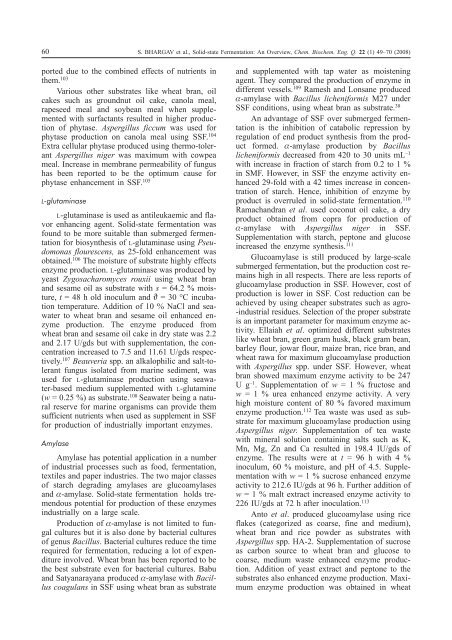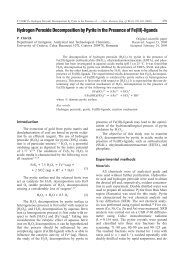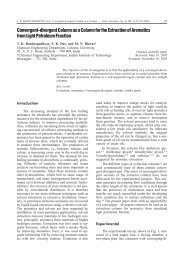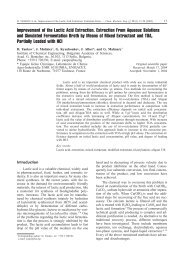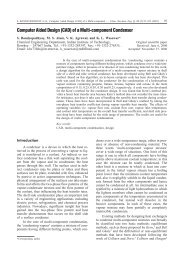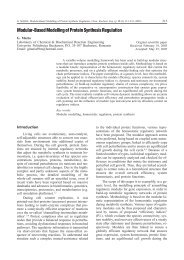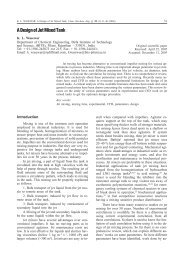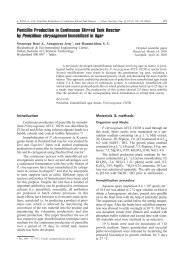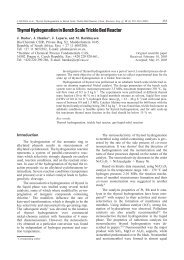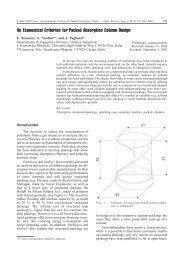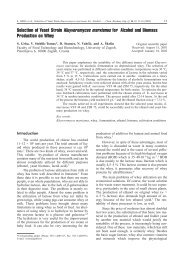Solid State Fermentation: An Overview - pierre
Solid State Fermentation: An Overview - pierre
Solid State Fermentation: An Overview - pierre
You also want an ePaper? Increase the reach of your titles
YUMPU automatically turns print PDFs into web optimized ePapers that Google loves.
60 S. BHARGAV et al., <strong>Solid</strong>-state <strong>Fermentation</strong>: <strong>An</strong> <strong>Overview</strong>, Chem. Biochem. Eng. Q. 22 (1) 49–70 (2008)ported due to the combined effects of nutrients inthem. 103Various other substrates like wheat bran, oilcakes such as groundnut oil cake, canola meal,rapeseed meal and soybean meal when supplementedwith surfactants resulted in higher productionof phytase. Aspergillus ficcum was used forphytase production on canola meal using SSF. 104Extra cellular phytase produced using thermo-tolerantAspergillus niger was maximum with cowpeameal. Increase in membrane permeability of fungushas been reported to be the optimum cause forphytase enhancement in SSF. 105L-glutaminaseL-glutaminase is used as antileukaemic and flavorenhancing agent. <strong>Solid</strong>-state fermentation wasfound to be more suitable than submerged fermentationfor biosynthesis of L-glutaminase using Pseudomonasflourescens, as 25-fold enhancement wasobtained. 106 The moisture of substrate highly effectsenzyme production. L-glutaminase was produced byyeast Zygosacharomyces rouxii using wheat branand sesame oil as substrate with s = 64.2 % moisture,t = 48 h old inoculum and = 30 °C incubationtemperature. Addition of 10 % NaCl and seawaterto wheat bran and sesame oil enhanced enzymeproduction. The enzyme produced fromwheat bran and sesame oil cake in dry state was 2.2and 2.17 U/gds but with supplementation, the concentrationincreased to 7.5 and 11.61 U/gds respectively.107 Beauveria spp. an alkalophilic and salt-tolerantfungus isolated from marine sediment, wasused for L-glutaminase production using seawater-basedmedium supplemented with L-glutamine(w = 0.25 %) as substrate. 108 Seawater being a naturalreserve for marine organisms can provide themsufficient nutrients when used as supplement in SSFfor production of industrially important enzymes.AmylaseAmylase has potential application in a numberof industrial processes such as food, fermentation,textiles and paper industries. The two major classesof starch degrading amylases are glucoamylasesand -amylase. <strong>Solid</strong>-state fermentation holds tremendouspotential for production of these enzymesindustrially on a large scale.Production of -amylase is not limited to fungalcultures but it is also done by bacterial culturesof genus Bacillus. Bacterial cultures reduce the timerequired for fermentation, reducing a lot of expenditureinvolved. Wheat bran has been reported to bethe best substrate even for bacterial cultures. Babuand Satyanarayana produced -amylase with Bacilluscoagulans in SSF using wheat bran as substrateand supplemented with tap water as moisteningagent. They compared the production of enzyme indifferent vessels. 109 Ramesh and Lonsane produced-amylase with Bacillus licheniformis M27 underSSF conditions, using wheat bran as substrate. 38<strong>An</strong> advantage of SSF over submerged fermentationis the inhibition of catabolic repression byregulation of end product synthesis from the productformed. -amylase production by Bacilluslicheniformis decreased from 420 to 30 units mL –1with increase in fraction of starch from 0.2 to 1 %in SMF. However, in SSF the enzyme activity enhanced29-fold with a 42 times increase in concentrationof starch. Hence, inhibition of enzyme byproduct is overruled in solid-state fermentation. 110Ramachandran et al. used coconut oil cake, a dryproduct obtained from copra for production of-amylase with Aspergillus niger in SSF.Supplementation with starch, peptone and glucoseincreased the enzyme synthesis. 111Glucoamylase is still produced by large-scalesubmerged fermentation, but the production cost remainshigh in all respects. There are less reports ofglucoamylase production in SSF. However, cost ofproduction is lower in SSF. Cost reduction can beachieved by using cheaper substrates such as agro--industrial residues. Selection of the proper substrateis an important parameter for maximum enzyme activity.Ellaiah et al. optimized different substrateslike wheat bran, green gram husk, black gram bean,barley flour, jowar flour, maize bran, rice bran, andwheat rawa for maximum glucoamylase productionwith Aspergillus spp. under SSF. However, wheatbran showed maximum enzyme activity to be 247Ug –1 . Supplementation of w = 1 % fructose andw = 1 % urea enhanced enzyme activity. A veryhigh moisture content of 80 % favored maximumenzyme production. 112 Tea waste was used as substratefor maximum glucoamylase production usingAspergillus niger. Supplementation of tea wastewith mineral solution containing salts such as K,Mn, Mg, Zn and Ca resulted in 198.4 IU/gds ofenzyme. The results were at t = 96 h with 4 %inoculum, 60 % moisture, and pH of 4.5. Supplementationwith w = 1 % sucrose enhanced enzymeactivity to 212.6 IU/gds at 96 h. Further addition ofw = 1 % malt extract increased enzyme activity to226 IU/gds at 72 h after inoculation. 113<strong>An</strong>to et al. produced glucoamylase using riceflakes (categorized as coarse, fine and medium),wheat bran and rice powder as substrates withAspergillus spp. HA-2. Supplementation of sucroseas carbon source to wheat bran and glucose tocoarse, medium waste enhanced enzyme production.Addition of yeast extract and peptone to thesubstrates also enhanced enzyme production. Maximumenzyme production was obtained in wheat


